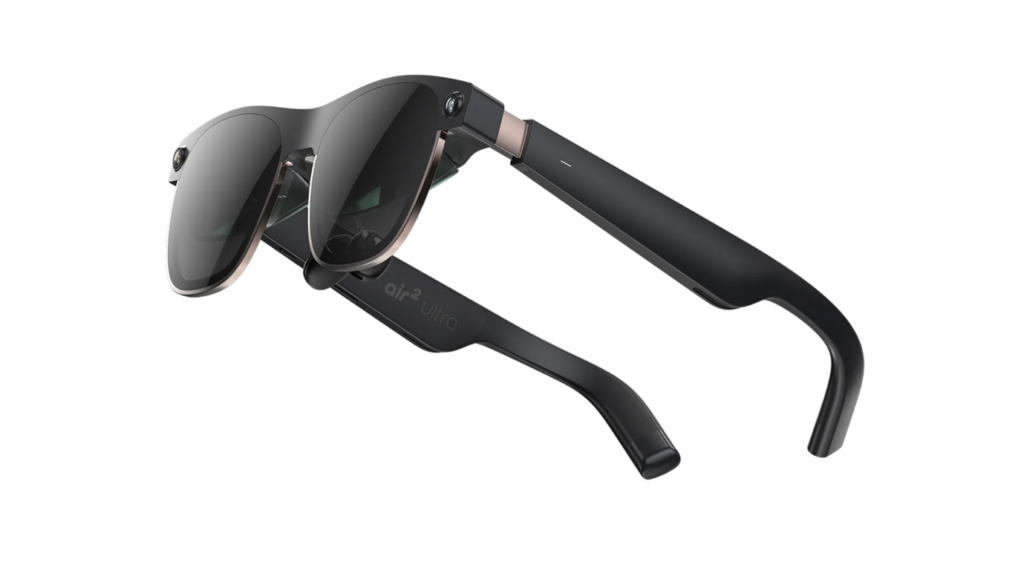Xreal has announced the Xreal Air 2 Ultra, part of the company’s AR glasses series. Priced at US $699, it offers 6DoF through dual 3D environment sensors. The glasses have a sleek titanium ring frame, offer a high-definition viewing experience, and support virtual 2D screencasting. Xreal aims to empower developers with an affordable solution for creating mixed reality experiences. The glasses will be available for pre-order, and shipments are expected to begin in March.
What do we think? Apple set the tone with its focus on spatial computing, and now everyone else is following. In part, Xreal is in the Apple ecosystem, supporting Apple’s latest spatial video features. Xreal is a true leader, with a slight majority share of the market, but that was before CES 2024, where there are notable AR announcements from Qualcomm partners, and before Apple starts to ship Vision Pro, now expected in this quarter. With a keen price, Xreal might maintain a strong place, and we think it will displace Meta’s Quest 3 as the best entry-level device, but it will be a struggle for them to still be the market leader when CES 2025 rolls around. Ultimately, the developer strategy will prove crucial, and we’ll be watching that closely. Xreal is open about its main focus today being on developers rather than consumers.
Another interesting differentiation is that Xreal has gone with direct projection rather than the pass-through method, which overlays virtual objects on a video feed; it is used by Apple and Meta.
We don’t have official specs for the processor being used, but we understand it is a custom Snapdragon AR processor (not the newly announced Snapdragon XR2+ Gen 2).
Custom AR processors seem to be the thing for the current generation of product: MediaTek did one for Sony, Qualcomm has done a couple too, including perhaps this one. But we suspect that once MediaTek has done its Meta custom processor, the trend will be toward less customization as the market matures.
Xreal Air 2 Ultra to launch for US $699, with shipments in March 2024
Xreal says it has a mission to make augmented reality (AR) accessible to everyone. They have announced their latest product, the Xreal Air 2 Ultra, which is part of the Xreal Air series of AR glasses.
The Xreal Air 2 Ultra boasts six degrees of freedom (6DoF) through dual 3D environment sensors with computer vision capabilities. This device aims to energize the spatial computing developer community by offering an affordable alternative to other competing devices such as the Apple Vision Pro and Meta Quest 3.
The device features a sleek titanium ring frame that resembles the iconic Wayfarer design. The Xreal Air 2 Ultra is currently available for pre-order at US $699, and shipments are expected to begin in March.

“With Xreal Air 2 Ultra, we’re empowering developers around the world by providing an affordable and lightweight solution that allows them to jump into the exciting world of spatial computing and create the next generation of mixed reality experiences,” said Chi Xu, founder and CEO of Xreal.
Xreal is unveiling “The Spatial Life” experience at the Xreal booth during CES 2024. The Spatial Life demo allows familiar 2D applications and widgets to become fully immersive in 3D, seamlessly blending into the physical surroundings of the AR glasses wearer. This creates an infinite canvas for apps that goes beyond traditional screens, enabling users to multitask through augmented overlays without losing spatial presence. The interaction is controlled by the user’s eyes, hands, and voice, providing a natural and intuitive input method.
Xreal Air 2 Ultra includes Nebula, Xreal’s AR environment launcher available for Android, Mac, and Windows. The package also includes Xreal’s latest SDK, which focuses on spatial computing technology and utilizes the new in-frame sensors developed by Xreal. Additionally, Xreal will introduce the Mirage Shard Tracking Kit, a proprietary and patented technology for developers. This kit empowers users to interact with virtual interfaces through physical buttons.
The Xreal Air 2 Ultra glasses are equipped with a pair of 3D environment sensors that have computer vision capabilities. These sensors enable simultaneous location and mapping, allowing users to determine their position within a 3D space. This elegant approach to spatial computing offers impressive real-time performance without requiring intensive processing.
The 3D environment sensors featured in the Xreal Air 2 Ultra glasses are said to be the smallest on the market. They are specifically designed to create augmented reality apps and explore new spatial computing experiences. These sensors unlock various features such as hand tracking, 3D mesh creation, semantic scene understanding, and more. Additionally, they have the potential to support future AI capabilities.
The Xreal Air 2 Ultra glasses provide a high-definition viewing experience of Full HD for each eye, thanks to Xreal’s advanced proprietary optical engine. With a field of view (FOV) of 52 degrees and 42 pixels per degree (PPD), the Xreal Air 2 Ultra glasses are expected to offer a higher visual experience compared to Apple’s Vision Pro. The glasses have a fast refresh rate of up to 120 Hz and a peak brightness of 500 nits, ensuring that images appear crisp and vibrant, even in different lighting conditions.
Customers can use virtual 2D screencasting with the Xreal Air 2 Ultra glasses, projecting an equivalent of a 154-inch screen from a distance of 13 feet. Furthermore, the glasses feature cinematic-grade audio and directional audio technology, which reduces sound dispersion for better privacy and minimal disturbance to others.
In addition to the Xreal Air 2 Ultra, both the Xreal Air 2 and Xreal Air 2 Pro also support Apple’s latest spatial video feature. Users can convert spatial videos captured on an iPhone 15 Pro to a regular side-by-side format using third-party iPhone apps. These converted videos can then be viewed on the Xreal Air 2 series glasses. This provides users with the opportunity to experience spatial video from their iPhone 15 Pro without needing to invest in the expensive Apple Vision Pro.
